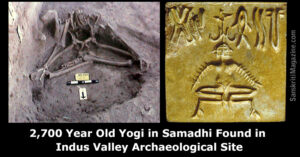The history of yoga and it’s practices are deeply rooted in ancient tradition. Evidence of Yogic Philosophy or Practice predates the earliest Sanskrit texts (i.e. Rig Veda ~3500BCE) and there is constant debate of the oral traditions of yoga ~10,000BCE (Neolithic Period).
WOW! It can be overwhelming at first, right?
Where the heck do you start? Have no worries, friends! I have all the QUICK info here to start your journey.
My teachers put Yogic History like this: 3 people, 4 Books, 2 cities
(Keep scrolling if you’re looking for the classical yoga list)
Three people:
- Swami Vivekananda
- Paramahansa Yogananda
- Krishnamacharya
Four Books:
- Rig Veda
- The Bhagvad Gita
- Patanjali’s Yoga Sutras
- Hatha Yoga Pradipika
Two cities:
- Harrapa
- Mohenjo-daro
Three people:
- Swami Vivekananda is our first example of ‘syncretism’ (or combination of beliefs) in regards to fusing American principles with the ancient traditions of India. He first lectured, then wrote about what he called the “Four Yogas”
- Four yogas: Raja yoga, Karma yoga, Bhakti Yoga, and Jnana Yoga
- Paramahansa Yogananda’s contributions are also syncretic in nature, blending Western and Eastern thought while adapting ancient teachings to a new audience.
- He is an incredibly prolific author, his most famous being, “Autobiography of a yogi.”
- Taught a varient of kriya yoga and promoted his own ‘yogoda’ system of exercise, meditation, and yoga.
- Krishnamacharya is considered as the father of yoga in the West. His background extensive with several swamis and teachers throughout his lifetime with many styles & traditions.
- He never traveled to America but gave tireless lectures throughout India.
- His four most famous disciples were Pattabhi Joise, B.K.S Iyengar, Indra Devi, and his own son, Desikachar.
- Influenced almost all American yoga being taught today, including the modern emphasis on headstands & shoulderstands that optimized sequencing of postures, and the combining of pranayama and asana, making the postures an integral part of meditation, and the association of specific asanas with particular therapeutic effects.
- Said to have transformed Hatha– a once obscure backwater of yoga—to what we know today. This is the reason we practice Hatha today.
Four Books:
- Rig Veda is the oldest known Vedic work. Uses the most archaic form of Vedic Sanskrit.
- ~as old as 3500 BCE with debate on being MUCH older, ~10,000 BCE. The written form being written about 600 BCE.
- Earliest existing copies are from the middle ages.
- References to yoga are limited, but they are there
- Bhagavad Gita
- Gita = Yoga of Action
- Composed around the time of the Rig Veda
- In here, Krishna instructs Arjuna on the principles of yoga. These principles are a meld of syncretic thought, showing elements of the following within: Hinduism, Buddhism, Jainism, and pre-Vedic Indian folk religion.
- Underlying precepts of yoga: stillness, meditation, right action, right intentions, unity of all mankind, and the unity of man & Universe/Devine.
- Patanjali’s Yoga Sutras
- “Sutras” means “to stitch” and is Yoga for the MIND.
- A series of aphorisms or concise statements about yoga.
- Dating of the ancient text is also debated.
- The sutras set out the best or (royal) path presenting as an 8 limb system or “ashtanga”. They are the 8 limbs of yoga.
- Yama = How we relate to the world (external forces)
- Niyama = How we relate to ourselves (internal forces)
- Asana = Movement. Prepares, purifies, strengthens, & brings physical awareness to the body.
- Pranayama = Controlled breath to organize, direct, and expand our vital energy.
- Pratyahara = Withdrawl from the senses to loosen attachment to desires & control the mind.
- Dharana = Ability to concentrate on one thing for a specific amount of time; meditation.
- Dhyana = Become “one” with the object of meditation
- Samadi = Eventually letting go to become who we TRULY are; self-realization, pure awareness/consciousness. (Ultimate yogi goal)
- Hatha Yoga Pradikipa is the FIRST detailed instruction on the practice of yoga.
- considered to be the precursor to modern yoga
- Written in 15th century A.D.
- Not the date for the origin of Hatha yoga, but is our first written text by living tradition (passed from teacher to student.)
- Contains references to kriya (cleansing), bandhas, mudras, and references to asana and pranayama.
Two Cities: Harrapa and Mohenjo-Daro


- In the Indus Valley, More than 4,000 years ago, the Harappa culture thrived in the Indus River Valley of what is now modern Pakistan and northwestern India.
- Here they built sophisticated cities, invented sewage systems that predated ancient Rome’s & the Egyptians, and engaged in long-distance trade with settlements in Mesopotamia.
- Yoga has been linked to this culture through archeological discoveries, providing clear evidence of yogic meditation & asana practice.

